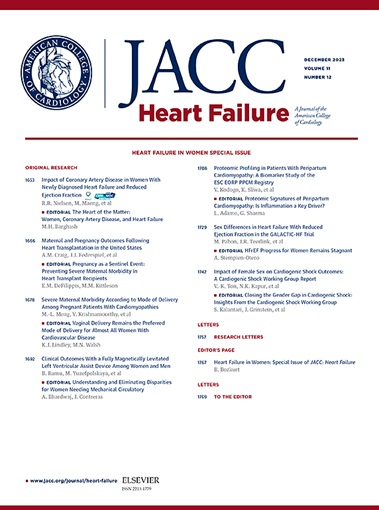依普利酮在肥厚性心肌病中的抗纤维化作用:一项随机临床试验。
IF 10.3
1区 医学
Q1 CARDIAC & CARDIOVASCULAR SYSTEMS
引用次数: 0
摘要
背景:纤维化在肥厚性心肌病(HCM)中起核心作用,通过收缩和舒张功能受损以及室性心律失常导致症状。目的:本研究的目的是确定依普利酮是否对非阻塞性HCM具有抗纤维化作用(静息左心室流出道梯度)方法:这是一项随机、双盲、安慰剂对照试验,在61例非阻塞性HCM患者中进行了12个月的依普利酮治疗。主要终点是心脏磁共振T1时间作为弥漫性纤维化的指标。次要终点包括舒张功能的改变。结果:30例患者随机接受50mg埃普利酮治疗,31例接受安慰剂治疗。依普利酮组的T1时间减少(基线时为1315±134 ms, 12个月时为1259±92 ms);P = 0.041),安慰剂组无显著变化(基线时1234±28 ms vs 12个月时1238±70 ms;P = 0.854)。这表明,与安慰剂组相比,eplerenone组原生T1减少3.7%±9%,而安慰剂组增加1.1%±9% (P = 0.07)。功能状态或舒张功能指标(如E/ E′比值或二尖瓣E/A比值)无明显变化。结论:在非阻塞性HCM患者中,依普利酮可减少心肌T1时间,与弥漫性心肌纤维化的减少一致。需要更大规模、更长期的试验来证实这一发现,并探索它是否会随着时间的推移而提高运动能力或降低死亡率。依普利酮对肥厚性心肌病弥漫性心肌纤维化及舒张功能的抗纤维化作用;ACTRN12613000065796)。本文章由计算机程序翻译,如有差异,请以英文原文为准。
The Antifibrotic Effects of Eplerenone in Hypertrophic Cardiomyopathy
Background
Fibrosis plays a central role in hypertrophic cardiomyopathy (HCM), contributing to symptoms via impaired systolic and diastolic function and ventricular arrhythmias.
Objectives
The aim of this study was to determine if eplerenone has an antifibrotic effect in nonobstructive HCM (resting left ventricular outflow tract gradient <30 mm Hg).
Methods
This was a randomized, double-blind, placebo-controlled trial of eplerenone in 61 patients with nonobstructive HCM over 12 months. The primary endpoint was native T1 time on cardiac magnetic resonance as an index of diffuse fibrosis. Secondary endpoints included changes in diastolic function.
Results
Thirty patients were randomized to 50 mg eplerenone and 31 to placebo. There was a reduction in native T1 time within the eplerenone group (1,315 ± 134 ms at baseline vs 1,259 ± 92 ms at 12 months; P = 0.041), with no significant change in the placebo group (1,234 ± 28 ms at baseline vs 1,238 ± 70 ms at 12 months; P = 0.854). This represents a 3.7% ± 9% reduction in native T1 with eplerenone compared with a 1.1% ± 9% increase with placebo (P = 0.07). There was no significant change in functional status or markers of diastolic function (such as E/e′ ratio or mitral E/A ratio).
Conclusions
In patients with nonobstructive HCM, there was a reduction in myocardial T1 time with eplerenone, consistent with a reduction in diffuse myocardial fibrosis. Larger and longer trials are needed to confirm this finding and explore whether it translates into improved exercise capacity or a reduction in mortality over time. (Anti-fibrotic role of eplerenone on diffuse myocardial fibrosis and diastolic function in patients with hypertrophic cardiomyopathy; ACTRN12613000065796)
求助全文
通过发布文献求助,成功后即可免费获取论文全文。
去求助
来源期刊

JACC. Heart failure
CARDIAC & CARDIOVASCULAR SYSTEMS-
CiteScore
21.20
自引率
2.30%
发文量
164
期刊介绍:
JACC: Heart Failure publishes crucial findings on the pathophysiology, diagnosis, treatment, and care of heart failure patients. The goal is to enhance understanding through timely scientific communication on disease, clinical trials, outcomes, and therapeutic advances. The Journal fosters interdisciplinary connections with neuroscience, pulmonary medicine, nephrology, electrophysiology, and surgery related to heart failure. It also covers articles on pharmacogenetics, biomarkers, and metabolomics.
 求助内容:
求助内容: 应助结果提醒方式:
应助结果提醒方式:


